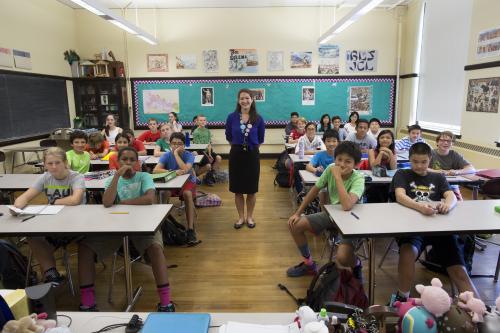Over the past few years, there has been renewed interest in the impact of minimum teacher qualifications on the child care market. Indeed, an important debate is now underway over the new staff education requirements being rolled out in Washington, D.C. When the changes are fully implemented, directors of center-based child care programs will be required to have a bachelor’s degree, while lead teachers will be required to have an associate’s degree. In addition, Sen. Elizabeth Warren’s new universal child care proposal generated substantial debate over the requirement that publicly funded programs would have to meet “high-quality standards.”
Advocates of tougher teacher qualifications—and of regulations more generally—argue that such requirements are an inexpensive but effective way to increase program quality. In particular, policymakers may be drawn to regulations because their costs are not borne primarily by the government, nor are they easily quantified. Critics, on the other hand, claim these requirements increase the cost of child care production, thereby forcing providers to either increase prices (to offset the required investments) or exit the market.
“If a given program requirement is already surpassed by many providers, then we would expect it to have little impact on the child care market.”
Critical to understanding the likely impact of teacher qualifications on the child care market is this question: To what extent do providers voluntarily exceed the minimum standards? If a given program requirement is already surpassed by many providers, then we would expect it to have little impact on the child care market. For example, if a center-based provider that elects to hire lead teachers with an associate’s degree in the absence of a regulation faces a requirement that teachers must have a high school diploma, then such a requirement would not alter its behavior. Thus, the key question is: What share of child care providers voluntarily operate above a given requirement? As this proportion becomes larger, the expected impact of the requirement will shrink.
Findings from a study of teacher hiring practices
In a recently published paper, my colleague Casey Boyd-Swan and I shed light on this issue. We conducted a field experiment that examined teacher hiring practices in the market for center-based care. Specifically, we administered a resume audit study that randomly assigned a number of job-seeker characteristics (e.g., work experience, education level, and field of study) to resumes submitted on behalf of fictitious individuals in response to real job advertisements on a large, online job board. Altogether we submitted nearly 11,000 resumes to 2,800 child care providers located in 17 states.
In the course of collecting data for the field experiment, we coded providers’ minimum teacher experience and education requirements in the posted job advertisements. Doing so allowed us to compare programs’ requirements for two key characteristics—work experience and level of education—with the corresponding state regulation, thereby providing a unique opportunity to examine whether these regulations are binding as well as the degree of compliance.
Our analysis uncovered three noteworthy results. First, it is quite common for child care providers to post experience and education requirements that exceed the state’s minimum standard. For example, among providers located in states requiring less than one year of work experience, approximately 88 percent of teacher job advertisements required applicants to have at least one year of experience. Similarly, among providers in states requiring one year of experience, 31 percent of job advertisements sought applicants with two or more years of experience. As for teachers’ education requirements, we found similar patterns. Fully 25 percent of providers located in states requiring a high school degree wanted teachers with at least an associate’s degree. In addition, among those faced with a state mandate requiring teachers to have some college education (up to an associate’s degree), approximately 27 percent of providers nevertheless sought applicants with a bachelor’s degree.
Second, despite the fact that many providers appear to be operating above the regulated minimum standards, we uncovered evidence consistent with noncompliance. Not surprisingly, this was particularly true for providers in states with very strict experience and education regulations. For example, among providers facing a minimum experience requirement of at least two years, approximately 58 percent of job postings required only a year (or less) of experience. Furthermore, we found that providers located in states with the most stringent education regulation—those requiring teachers to have a bachelor’s degree—24 percent advertised positions requiring only a high school diploma, and another 33 percent advertised positions requiring an associate’s degree.
Finally, it appears that providers operating in states without an explicit regulation have teacher requirements that are similar to their counterparts in states that do regulate a given feature. To take one example, we found that 1 percent of job postings in unregulated states sought teachers with less than one year of experience, while 68 percent of postings sought teachers with exactly one year of experience, and 32 percent sought those with two or more years. These requirements are higher on average than those set by providers in states with an experience regulation of less than one year (12 percent, 58 percent, and 30 percent, respectively), and are virtually identical to those set by providers in states with a regulated minimum of one year (zero percent, 69 percent, and 31 percent, respectively).
Implications
So, what are we to make of these results? One conclusion is that for many child care providers, the state regulations for teacher experience and education are not likely to matter. Our results are consistent with an analysis conducted by David Blau, who found that an overwhelming majority of providers were operating above the regulated minimum standards for staff-child ratios and maximum group sizes. Given that many providers voluntarily exceed these regulations, one might reasonably conclude that they have, at most, only small effects on the child care market. In the district, for example, fully two-thirds of the programs in our study were already in compliance with the yet-to-be, phased-in teacher requirements.
“For many child care providers, the state regulations for teacher experience and education are not likely to matter.”
Another takeaway from our research—also consistent with Blau’s analysis—is that a nontrivial share of providers appear to be noncompliant with the teacher standards, in that many providers advertise job requirements that fall below states’ minimum standards. Of course, there may be differences between providers’ advertised teacher requirements and the characteristics of those ultimately hired, but it is concerning that 14 percent of the fictitious resumes that were noncompliant with the state regulations nevertheless received an interview request. These findings raise important questions about whether the regulations are being adequately enforced. If providers find it easy to evade the regulations, then these rules are not fulfilling one of their core functions: to improve child care quality—particularly among low-quality providers—by compelling them to invest or exit the market.
A final conclusion is that even in the absence of explicit minimum teacher requirements, some child care providers are willing to hire well-qualified teachers. There are two ways to interpret this. One is that removing (or substantially lowering) regulatory “barriers” may not produce a race to the bottom, as some may fear. But another interpretation is that if the requirements are too lenient, states may actually encourage providers to hire less qualified teachers than they would without the rule. These possibilities, coupled with the fact that many providers voluntarily exceed the minimum standards, imply that states must be thoughtful about the level at which a given requirement is set. In addition, this discussion suggests that the current regulatory environment in the U.S. is not overly restrictive and thus not likely to have large adverse effects on the child care market.
Having said this, critics and supporters of regulations may agree that such policies are not the preferred approach to improve child care quality. Regulations ensure that only a minimum level of quality is achieved, and providers are compelled—rather than encouraged—to comply with the rules. An alternative approach is to give providers strong incentives to improve quality. For example, most states now operate a Quality Rating and Improvement System (QRIS), which combines consumer education with financial incentives to encourage quality investments that often greatly exceed the standards set through states’ regulations. Thus, in the coming years—as states’ QRIS fully mature—it will be interesting to see whether these rating systems relegate states’ regulatory policies to the backburner of quality improvement efforts.







Commentary
Why requiring teacher qualifications for child care might not matter in practice
March 26, 2019